
This website contains multiple games for kids, ranging from ELA to Math.
- Subject:
- English Language Arts
- Media Studies
- Science
- Material Type:
- Game
- Date Added:
- 03/25/2019

This website contains multiple games for kids, ranging from ELA to Math.
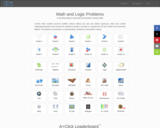
This site offers math and logic problems for ages 5 and up to adult.
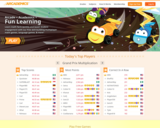
Arcademics make multiplayer educational games for students from K to eighth grade, from free math games to language games. Arcademics combines the excitement of video games with educational content to produce a high rate of learning through exciting, focused repetition that enables automaticity and fluency. All games can be played seamlessly on any device using the web browser for free.
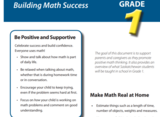
A series of pamphlets has been developed with the goal of supporting parents and caregivers as they promote positive math thinking in the home. The printable pamphlets, developed in collaboration with sector partners, also provide an overview of what students will be taught in school in each of grades 1-9, based on Saskatchewan curricula.

Get your students coding in no time!
CodeMonkey is a fun and educational game-based environment where kids learn to code without any prior experience. After completing CodeMonkey's award-winning coding courses, kids will be able to navigate through the programming world with a sense of confidence and accomplishment.
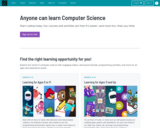
FULL COURSES are available here for students.
Learn to make your own game, app, or computer drawing. (K-5)
Build real working apps, games and websites using blocks, JavaScript, CSS, HTML and more. (6-9)
Go beyond Code.org and take university courses online or learn a new programming language. (10-12)
Plus access to all the Hour of Code games/coding activities!

Counting Collections is an important mathematical routine that students or families can do with very little guidance at home. Teachers could make kits with available resources for use at home, or send suggestions for commonly found objects that families could use for counting practice at home.
Counting Collections are just as described; they are collections of items that students count. Depending on your students, you will need several different kits. Kits hold several different collections of items.

Ten printable colouring pages which depict the numbers one through ten. Each page has a spelled-out number in Michif, the language of Métis Peoples’, as well as the numerical equivalence. There are also images of culturally significant items on each page, which correspond with the respective number. There are written instructions on the bottom of each page that indicate different activities that supplement the colouring pages.

Create additions, subtraction, multiplication and division worksheets to print or solve online
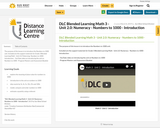
The purpose of this lesson is to introduce the Numbers to 1000 unit.
Included are the support materials for Grade 3 Blended Learning Math - Unit 2.0: Patterning -Numbers to 1000 - Introduction:
- YouTube video on introducing the unit on Numbers to 1000
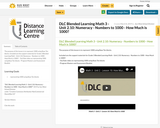
The purpose of this lesson is to represent 1000 using Base Ten blocks.
Included are the support materials for Grade 3 Blended Learning Math - Unit 2.10: Numeracy - Numbers to 1000 - How Much is 1000?:
- YouTube video on representing 1000 using Base Ten blocks

The purpose of this lesson is to read and represent numbers over 100.
Included are the support materials for Grade 3 Blended Learning Math - Unit 2.1: Numeracy - Numbers to 1000 - Counting Larger Collections:
- YouTube video on counting larger collections
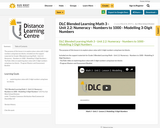
The purpose of this lesson is to explore place value with 3-digit numbers using base ten blocks.
Included are the support materials for Grade 3 Blended Learning Math - Unit 2.2: Numeracy - Numbers to 1000 - Modelling 3-Digit Numbers:
- YouTube video on exploring place value with 3-digit numbers using base ten blocks
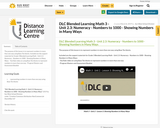
The purpose of this lesson is to represent numbers in more than one way using Base Ten blocks.
Included are the support materials for Grade 3 Blended Learning Math - Unit 2.3: Numeracy - Numbers to 1000 - Showing Numbers in Many Ways:
- YouTube video on using Base Ten blocks to represent numbers in more than one way
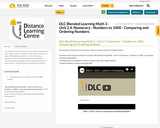
The purpose of this lesson is to use place value to compare and order 3-digit numbers.
Included are the support materials for Grade 3 Blended Learning Math - Unit 2.4: Numeracy - Numbers to 1000 - Comparing and Ordering Numbers:
- YouTube video on using place value to compare and order 3-digit numbers
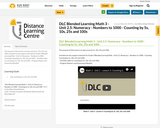
The purpose of this lesson is to skip count by 5s, 10s, 25s and 100s.
Included are the support materials for Grade 3 Blended Learning Math - Unit 2.5: Numeracy - Numbers to 1000 - Counting Counting by 5s, 10s, 25s and 100s:
- YouTube video on counting by 5s, 10s, 25s and 100s,
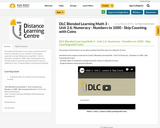
The purpose of this lesson is to use skip counting to find the value of a collection of coins.
Included are the support materials for Grade 3 Blended Learning Math - Unit 2.6: Numeracy - Numbers to 1000 - Skip Counting with Coins:
- YouTube video on using skip counting to find the value of a collection of coins
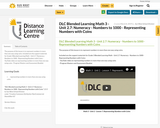
The purpose of this lesson is to represent numbers in more than one way using coins.
Included are the support materials for Grade 3 Blended Learning Math - Unit 2.7: Numeracy - Numbers to 1000 - Representing Numbers with Coins:
- YouTube video on representing numbers in more than one way using coins
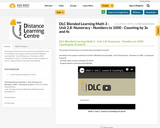
The purpose of this lesson is to practice skip counting by 3s and 4s.
Included are the support materials for Grade 3 Blended Learning Math - Unit 2.8: Numeracy - Numbers to 1000 - Counting by 3s and 4s:
- YouTube video on skip counting by 3s and 4s
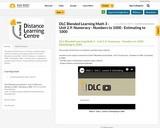
The purpose of this lesson is to estimate a quantity using a referent.
Included are the support materials for Grade 3 Blended Learning Math - Unit 2.9: Numeracy - Numbers to 1000 - Estimating to 1000: